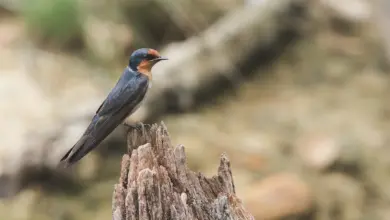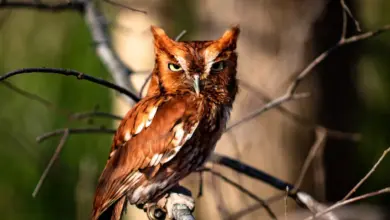Diamond Firetail Finches or Diamond Sparrows
The Diamond Firetail Finches (Stagonopleura guttata – occasionally placed into genus Emblema) are also commonly referred to as Java or Diamond Sparrows or Spot-sided Finches.
They are one of four Firetail finch species found in Australia. The name “Firetail” was derived from their fiery red rump and tail feathers.
Because of their striking, attractive plumage, Diamond Firetails are popular in aviculture and are commonly kept as pets. Within their natural range, their numbers have been adversely affected by clearing for agriculture or urban development, as well as predation of their eggs and young.
Therefore, these finches are classified as Endangered or Vulnerable.
These social birds are usually found in pairs or in small groups of up to five individuals. Outside the breeding season, they may be seen in large flocks with fifty birds or more of them hopping around on the ground in their search for food.
They also occur in mixed species flocks with other grass finch species. When flushed from the ground, their wings often make a loud “whirr” sound.
Their life span is usually between 5 to 7 years, but well-cared-for captive birds can expect to live up to 10 years.
Distribution / Habitat
The Diamond Firetail is endemic to central eastern and southeastern Australia. Their range stretches from the Carnarvon mountain range in lower central Queensland (about 520 km west-northwest of Brisbane) south through Yeoval (the western limit) to southern Victoria and west to Kangaroo Island and southern Eyre Peninsula.
They are most common on the slopes of the Great Dividing Mountain Range.
They mostly inhabit grassy eucalypt forests, woodlands, mallee country, or grassland areas with scattered trees along rivers and creeks. They occasionally occur on farmland / agricultural areas or open forests.
Their numbers have declined in density throughout their native range – particularly in the most intensively developed parts of their native range – and many populations are now isolated.
Diamond Firetail finches are mostly resident or sedentary, except for some local, seasonal movements in response to rainfall and availability of food.
Description
Size (Average)
Length: 4 – 5 inches (10 – 13 cm)
Weight: 0.6 oz (17 g)
Wingspan: 10.24 inches (26 cm)
Plumage Details / Adults
Upper plumage: Ash brown except for the silver-grey crown, forehead and neck and the red rump.
The plumage below is white except for the black band across the upper chest which then continues down the sides (flanks) with some distinctive white spotting.
The lores (area between the eyes and the bill) are black.
The throat is white.
Other Physical Details
- The bill and eye rings are dark red.
- Legs and feet are dark grey.
Gender ID
Males and females look alike and are generally difficult to sex, except for some slight differences that may or may not be discernible (noticeable):
- the female has a narrower “bib” and paler lores (area between the eyes and the beak);
- the female may be a smaller size;
- the head of a male may also be squarer than that of a female and broader across the top;
- the male’s beak and eye rings are a deeper red; and
- the tail is black in the male and brownish-black in the female.
- Females develop a pinker beak when they are 3 – 4 years of age
Song: These finches are most reliably sexed by the males’ courtship displays and their songs. The female’s song is described as a “scratchy” version of the male. Some breeders suggest observing these finches for a while and choosing a pair with voices that are the most different.
Juvenile Description
The immature Diamond Firetail finch has a black bill and duller plumage.
Color mutations produced in captivity
Similar Species
- Red-browed Finches (Neochmia temporalis) – smaller and more slender-bodied than the Diamond Firetail.
- House Sparrows (Passer domesticus) – duller plumage, slightly larger and longer tail than the Diamond Firetail
Diet / Feeding in the Wild
Diamond Firetails feed on ripe or partially ripe seeds and the leaves of grasses and herbs, as well as insects and their larvae (particularly when breeding), and ripe or partially ripe fruits.
These ground feeders act as seed disperses of the plants they feed on.
Diamonds drink water by sucking.
Breeding / Nesting
Diamond Firetail finches are monogamous and pairs often form before they reach breeding age. They are slow to accept a mate, but once they have done so, they generally remain bonded for life.
They reach breeding age when they are about 9 – 12 months old. If conditions are conducive to rearing young (plenty of food) they usually breed twice a year – once brood is raised in the spring and another in the fall.
The breeding season varies by location and by differences in climate between the years. They usually don’t breed in exceptionally hot or cold weather. Most breeding activities occur as follows:
Northern range: August / October – January (spring and fall)
Southern range: September – April
Nesting is preceded by the male’s courtship ritual, which involves holding a long piece of green grass in his bill, then flying to a branch where he sits near the female. Then he puffs out his chest and begins to bob up and down emitting a long raspy sound. As she approaches, he twists his neck around and opens his bill as if he were begging to be fed (mimicking the behavior of the young to encourage broodiness in the female). The female will show her acceptance by turning her tail towards the displaying male and crouching down, and copulation usually follows.
Both the male and the female cooperate in the construction of the nest. Males generally gather nest materials and females do all the weaving. The nest is usually located less than 33 feet (~10 meters) above the ground (although some have been recorded as high as 50 feet or ~15 meters above the ground) in dense foliage. The nest is an elaborate bottle-shaped dome with an outer shell of green grasses and a small woven entrance funnel on the front that measures up to 6 inches or 15 cm in length. Nests are often placed under hawk or raven nests to deter predators.
Unlike other birds that may often take over abandoned bird nests, Diamond Sparrows prefer to build their own. The material they use are taken from their environment – such as coconut fibers, dried grass, shredded paper and lined with soft grasses, feather down and feathers. Even after the nest has been constructed and young are being raised, the male will return to the nest with a blade of grass or a feather which he presents to the female.
A clutch consists of 4 – 6 eggs (sometimes as many as 9) which are incubated for about 12 – 15 days to hatching. Both parents share the incubation during the day, each one remaining on the nest for about one and a half hour at a time before being relieved by the mate. At night, both parents brood the eggs and later the young. The hatchlings are born pink skinned and just about naked. The parents feed regurgitated, half-ripe seeds to their hungry young who await them at the nest with their beaks wide open and moving their heads from side to side in anticipation of being fed. As they are being fed, they lay their necks flat on the nest floor turning their gape upwards. The young remain in the nest for about 21 – 30 days.
They continue to be fed and cared by their parents for some time after fledging. Most are weaned and independent by the time they are about 42 – 44 days old.
Calls / Vocalizations / Sounds
Different vocalizations have been noted:
- Contact call: a mournful, double whistle “twooo-heeee”
- Alarm call: “tay tay tay”
- Song: series of low-pitched, raspy, “buzzy” notes.
- Males mating / display call: a low raspy song, made while holding pieces of dried vegetation in his beak and hopping up and down
Alternate (Global) Names
Chinese: ????? … Czech: Amadina diamantová … Danish: Diamantfinke … Dutch: Diamantastrild, Diamantvink … Estonian: Teemantamadiin … Finnish: Timanttituliperä … French: Diamant à gouttelettes, Diamant à queue de feu … German: Diamantamadine … Italian: Diamante diamantino / moscato … Japanese: Ookinkachou … Norwegian: Diamantastrild, Diamantfink … Polish: Kra?niczek diamantowy, krasniczek diamentowy, kra?niczek diamentowy … Russian: ????????????? ??????? … Slovak: diamantovka bodkovaná … Spanish: Diamante Moteado, Pinzón Cola de Fuego Diamante … Swedish: Diamantfink
Further Finch Reading
- Finch Information
- Index of Finch Species
- Photos of the Different Finch Species for Identification
- Common Health Problems of Finches
- Finch / Canary Diet / Nutrition



